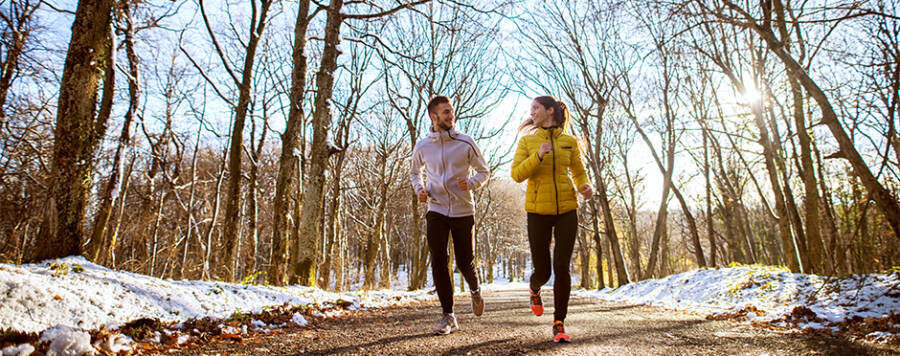Outdoor Winter Workout Tips
- Start by warming up indoors – this can include a 5-10 minute jog in place, jumping jacks or jumping rope. By doing this, your body starts off warmer when you go outside into the cold.
- Don’t exercise outside if the temperature is too cold – know your limits and make sure to check the wind chill before deciding to work out outdoors. In general, it is a good idea to exercise indoors if the wind chill is zero or below to avoid conditions like hypothermia or frostbite.
- Check the weather before you leave your house – make sure there isn’t a storm in the forecast or any large change in the weather that could leave you at increased risk for frostbite during the length of your workout.
- Try to work out outside when it is warmest, which is typically near midday – to do this, try exercising on your lunch break or leave your outdoor workouts for the weekends and supplement with indoor workouts during the week.
- Dress in layers –
- A sweat wicking fabric should be closest to your body (not cotton)
- The next layer is an insulation layer such as fleece or wool
- The outer layer should be waterproof
- Make sure to protect the head, hands, feet and ears
- Consider a scarf or mask that can cover the face if it is really cold
- Beware of icy conditions, as this can increase your risk for falling during a workout –
- Make sure you select footwear with good traction
- There are also removable options that can be attached to shoes to give added traction on icy sidewalks or terrain
- Know the signs of frostbite and hypothermia –
- skin color changes
- numbness
- tingling or stinging
- ice crystals on the skin
- vigorous shivering
- lethargy
- amnesia
- fine motor skill impairment
Other Options for Winter Workouts
Sometimes an outdoor workout is not going to happen during the winter months. This can be a great time to try a new workout or to change up your routine. There are several options that can be effective, including at-home workouts or gym workouts that could include using weights or joining a class. Here are a few options:
- Water workouts – these are a great change in pace and allow you to work muscles that may not get as much attention with traditional outdoor workouts. Find a local gym with a pool to try swimming or other water based workouts.
- Yoga – this is a great indoor activity that can help you focus on stretching, core strengthening, and can be a good compliment to your normal workout routines
- Something new – there are many workout options that may be new to your routine, including spin, Pilates, POUND, Zumba or body pump. These classes are a fun way to work out when the weather drives you indoors.
- Fun winter-specific workouts, like cross country skiing or snowshoeing – these are both amazing cardio and strengthening workouts for both the upper and lower body.
- Take the time during the winter months to focus on any problem areas that may have shown during the warmer months – if you had any areas of pain or weakness during the rest of the year, now is a great time to focus on stretching and strengthening that area to prevent any aggravation when you resume your regular outdoor workouts.
Heading into the Spring Injury-Free
Regardless of the workouts you try this winter, it is important to pay attention to your body so you can head into the warmer weather without injury and ready to resume your normal routine. Should unusual aches and pains occur during or after a workout, schedule a free assessment at a nearby Athletico so our experts can help you heal. Free Assessments are available in-clinic and virtually through our Telehealth platform.
The Athletico blog is an educational resource written by Athletico employees. Athletico bloggers are licensed professionals who abide by the code of ethics outlined by their respective professional associations. The content published in blog posts represents the opinion of the individual author based on their expertise and experience. The content provided in this blog is for informational purposes only, does not constitute medical advice and should not be relied on for making personal health decisions.
About the Author:
Tara Hackney, a physical therapist in Marion, IA, enjoys working with all patient types, especially gymnasts, cheerleaders, and dancers. She is the prominent blogger for Athletico's Gymnastic/Cheer Program. With an orthopedic specialization and training in dry needling and Graston technique, Tara hopes to answer your questions about injuries and injury prevention in an easy-to-understand manner. She hopes to ease fears surrounding pain and injuries, address concerns about recovery, and provide tips to prevent injury. In her free time, she enjoys spending time with her dog, reading, and watching her nephews play sports.

 width="900"
height="356"
>
width="900"
height="356"
>
